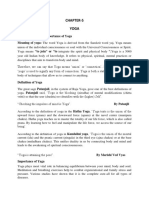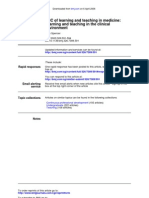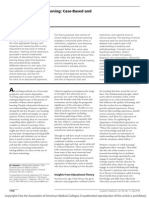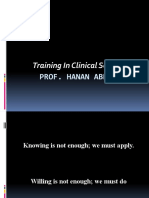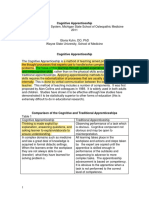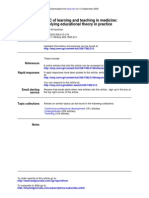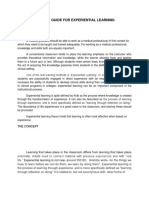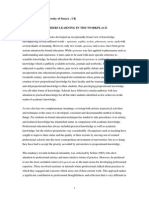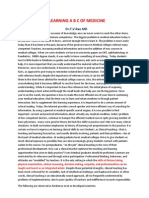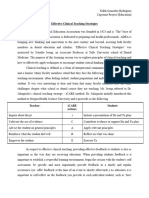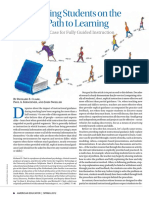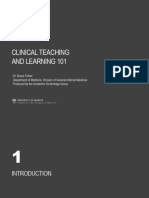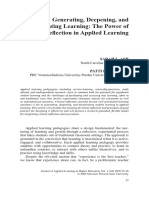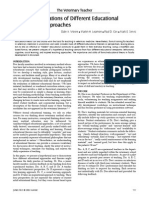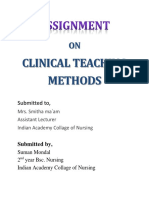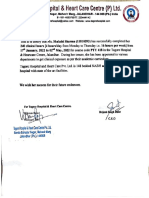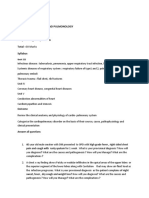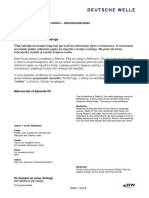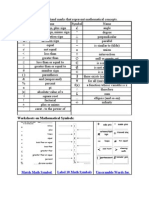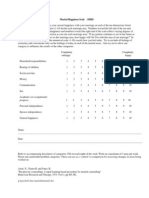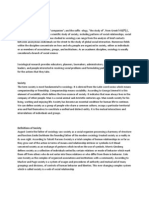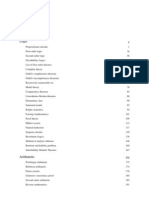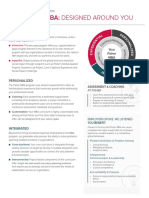0 ratings0% found this document useful (0 votes)
27 viewsLearning and Teaching in The Clinical Environment
Learning and Teaching in The Clinical Environment
Uploaded by
Atu KaushalThis document discusses effective clinical teaching strategies. It begins by explaining that clinical teaching, which involves teaching and learning focused on patients, lies at the heart of medical education. However, clinical teaching often lacks clear objectives, focuses too much on factual recall, and does not provide adequate feedback.
The document then discusses several principles for effective clinical teaching. Planning is important to provide structure for both teachers and students. Experiential learning theory holds that learning is most effective when based on experience, with a cyclical process of concrete experience, reflection, and planning. Questions can be used to clarify understanding, promote curiosity, and emphasize key points. Explanations should be clear and pitched at the appropriate level.
Copyright:
© All Rights Reserved
Available Formats
Download as PPTX, PDF, TXT or read online from Scribd
Learning and Teaching in The Clinical Environment
Learning and Teaching in The Clinical Environment
Uploaded by
Atu Kaushal0 ratings0% found this document useful (0 votes)
27 views14 pagesThis document discusses effective clinical teaching strategies. It begins by explaining that clinical teaching, which involves teaching and learning focused on patients, lies at the heart of medical education. However, clinical teaching often lacks clear objectives, focuses too much on factual recall, and does not provide adequate feedback.
The document then discusses several principles for effective clinical teaching. Planning is important to provide structure for both teachers and students. Experiential learning theory holds that learning is most effective when based on experience, with a cyclical process of concrete experience, reflection, and planning. Questions can be used to clarify understanding, promote curiosity, and emphasize key points. Explanations should be clear and pitched at the appropriate level.
Original Description:
Environment for learning
Original Title
Learning and teaching in the clinical environment
Copyright
© © All Rights Reserved
Available Formats
PPTX, PDF, TXT or read online from Scribd
Share this document
Did you find this document useful?
Is this content inappropriate?
This document discusses effective clinical teaching strategies. It begins by explaining that clinical teaching, which involves teaching and learning focused on patients, lies at the heart of medical education. However, clinical teaching often lacks clear objectives, focuses too much on factual recall, and does not provide adequate feedback.
The document then discusses several principles for effective clinical teaching. Planning is important to provide structure for both teachers and students. Experiential learning theory holds that learning is most effective when based on experience, with a cyclical process of concrete experience, reflection, and planning. Questions can be used to clarify understanding, promote curiosity, and emphasize key points. Explanations should be clear and pitched at the appropriate level.
Copyright:
© All Rights Reserved
Available Formats
Download as PPTX, PDF, TXT or read online from Scribd
Download as pptx, pdf, or txt
0 ratings0% found this document useful (0 votes)
27 views14 pagesLearning and Teaching in The Clinical Environment
Learning and Teaching in The Clinical Environment
Uploaded by
Atu KaushalThis document discusses effective clinical teaching strategies. It begins by explaining that clinical teaching, which involves teaching and learning focused on patients, lies at the heart of medical education. However, clinical teaching often lacks clear objectives, focuses too much on factual recall, and does not provide adequate feedback.
The document then discusses several principles for effective clinical teaching. Planning is important to provide structure for both teachers and students. Experiential learning theory holds that learning is most effective when based on experience, with a cyclical process of concrete experience, reflection, and planning. Questions can be used to clarify understanding, promote curiosity, and emphasize key points. Explanations should be clear and pitched at the appropriate level.
Copyright:
© All Rights Reserved
Available Formats
Download as PPTX, PDF, TXT or read online from Scribd
Download as pptx, pdf, or txt
You are on page 1of 14
Presented By- Dr.
Pushplata Arya,PT
Asst. Prof
LFAMS
Learning and teaching in the
clinical environment
Clinical teaching
That is, teaching and learning focused on, and
usually directly involving, patients and their
problems—lies at the heart of medical
education.
At undergraduate level, medical schools strive to
give students as much clinical exposure as
possible; they are also increasingly giving
students contact with patients earlier in the
course.
For postgraduates, “on the job” clinical teaching
is the core of their professional development.
How can a clinical teacher optimise the
teaching and learning opportunities that arise
in daily practice?
Strengths, problems, and challenges
Learning in the clinical Common problems with clinical
teaching
environment has many x Lack of clear objectives and
expectations
strengths. It is focused on x Focus on factual recall rather
real problems in the context than on development of
problem
of professional practice. solving skills and attitudes
Learners are motivated by x Teaching pitched at the wrong
level (usually too high)
its relevance and through x Passive observation rather
active participation. than active participation of
learners
Professional thinking, x Inadequate supervision and
behaviour, and attitudes are provision of feedback
x Little opportunity for reflection
“modelled” by teachers. and discussion
x “Teaching by humiliation”
x Informed consent not sought
from patients
The importance of planning
Many principles of good teaching,
however, can (and should) be
incorporated into clinical teaching.
One of the most important is the
need for planning.
Far from compromising spontaneity,
planning provides structure and
context for both teacher and
students, as well as a framework for
reflection and evaluation.
Preparation is recognised by students
as evidence of a good clinical teacher.
How doctors teach
Almost all doctors are involved in clinical teaching at
some point in their careers, and most undertake the
job conscientiously and enthusiastically. However,
few receive any formal training in teaching skills, and
in the past there has been an assumption that if a
person simply knows a lot about their subject, they
will be able to teach it. In reality, of course, although
subject expertise is important, itis not sufficient.
Effective clinical teachers use several distinct, if
overlapping, forms of knowledge.
How students learn
Understanding the learning process will help clinical teachers to
be more effective. Several theories are relevant.
Cognitive theories argue that learning involves processing
information through interplay between existing knowledge
and new knowledge. An important influencing factor is what
the learner knows already.
The quality of the resulting new knowledge depends not only
on “activating” this prior knowledge but also on the degree of
elaboration that takes place. The more elaborate the resulting
knowledge, the more easily it will be retrieved, particularly
when learning takes place in the context in which the
knowledge will be used.
Experiential learning
Experiential learning theory holds that learning is often most
effective when based on experience. Several models have
been described, the common feature being a cyclical process
linking concrete experience with abstract conceptualisation
through reflection and planning.
Reflection is standing back and thinking about experience
(What did it mean? How does it relate to previous experience?
How did I feel?).
Planning involves anticipating the application of new theories
and skills (What will I do next time?). The experiential learning
cycle, which can be entered at any stage, provides a useful
framework for planning teaching sessions.
Experiential learning
How to use cognitive learning theory in clinical
teaching
Help students to identify what they already know
x “Activate” prior knowledge through brainstorming and
briefing
Help students elaborate their knowledge
x Provide a bridge between existing and new
information—for example, use of clinical examples,
comparisons, analogies
x Debrief the students afterwards
x Promote discussion and reflection
x Provide relevant but variable contexts for the learning
Questions
Questions may fulfil many purposes, such as to
clarify understanding, to promote curiosity, and to
emphasise key points. They can be classified as
“closed,” “open,” and “clarifying” (or “probing”)
questions.
In theory, open questions are more likely to
promote deeper thinking, but if they are too broad
they may be equally ineffective. The purpose of
clarifying and probing questions is self evident.
Questions can be sequenced to draw out
contributions or be built on to promote thinking
at higher cognitive levels and to develop new
understanding
Explanation
Teaching usually involves a lot of explanation, ranging from the
(all too common) short lecture to “thinking aloud.” The latter is a
powerful way of “modelling” professional thinking, giving the
novice insight into experts’ clinical reasoning and decision
making (not easily articulated in a didactic way).
There are close analogies between teacher-student and doctor-
patient communication, and the principles for giving clear
explanations apply. If in doubt, pitch things at a low level and
work upwards.
As the late Sydney Jacobson, a journalist, said, “Never
underestimate the person’s intelligence, but don’t overestimate
their knowledge.” Not only does a good teacher avoid answer in
questions, but he or she also questions answers.
Teaching on the wards
Despite a long and
worthy tradition, the
hospital ward is not an
ideal teaching venue.
None the less, with
preparation and
forethought, learning
opportunities can be
maximised with
minimal disruption to
staff, patients, and
their relatives.
Teaching in the clinic
Although teaching during consultations is
organisationally appealing and minimally
disruptive, it is limited in what it can achieve
if students remain passive observers. With
relatively little impact on the running of a
clinic, students can participate more actively.
The patient’s role
Sir William Osler’s dictum that “it is a safe rule
to have no teaching without a patient for a
text, and the best teaching is that taught by
the patient himself” is well known.
The importance of learning from the patient
has been repeatedly emphasised. For
example, generations of students have been
exhorted to “listen to the patient—he is
telling you the diagnosis
Thank You…..
You might also like
- 11 Physical Education - Yoga-NotesDocument11 pages11 Physical Education - Yoga-NotesAtu Kaushal100% (7)
- How To Crush Medical School Flipbook PDF CompressDocument53 pagesHow To Crush Medical School Flipbook PDF CompressFelipeNo ratings yet
- Feu - Teaching-Learning Strategies in The Clinical SettingDocument31 pagesFeu - Teaching-Learning Strategies in The Clinical Settingrimeoznek100% (2)
- Bedside TeachingDocument18 pagesBedside TeachingUmmu Fatiha100% (1)
- NatureOfLearning PractitionerGuide US PDFDocument12 pagesNatureOfLearning PractitionerGuide US PDFCarlos Henrique Otoni Ferrer100% (1)
- Adult Learning Theory and Principles University of QueenslandDocument11 pagesAdult Learning Theory and Principles University of Queenslandjane kang100% (1)
- Quads Knee Strengthening ExercisesDocument7 pagesQuads Knee Strengthening ExercisesAtu KaushalNo ratings yet
- Teacher's Feature StoryDocument2 pagesTeacher's Feature StoryLope Adrian C. Acapulco82% (11)
- GOLDEN DAWN Instruction For The Zelator BookDocument3 pagesGOLDEN DAWN Instruction For The Zelator BookF_RC80% (5)
- ABC of Learning and Teaching in Medicine LearningDocument5 pagesABC of Learning and Teaching in Medicine LearningdrsheerazNo ratings yet
- Learning and Teaching in The Clinical EnvironmentDocument4 pagesLearning and Teaching in The Clinical EnvironmentDaniel Alejandro Lozano MorenoNo ratings yet
- Learning in ClinicalDocument5 pagesLearning in ClinicalSachin SonawaneNo ratings yet
- Sample Teaching Philosphy StatementsDocument11 pagesSample Teaching Philosphy StatementsMufaro PfendeNo ratings yet
- Teaching PhilosophyDocument9 pagesTeaching PhilosophyJairo EmarNo ratings yet
- Applying Educational Theory in PracticeDocument7 pagesApplying Educational Theory in PracticeBhe Che Link-linkNo ratings yet
- Teaching Communication Skills Using Role-Play An Experience Based Guide For EducatorsDocument6 pagesTeaching Communication Skills Using Role-Play An Experience Based Guide For EducatorsConstanza J. Cabaña AlvearNo ratings yet
- Kassirer 2010Document7 pagesKassirer 2010api-264671444No ratings yet
- Advanced Teaching SkillsDocument8 pagesAdvanced Teaching SkillsHany ElbarougyNo ratings yet
- TRAINING IN Clinical SETTINGDocument78 pagesTRAINING IN Clinical SETTINGHanan AbbasNo ratings yet
- Teaching Philosophy Statement Example #1Document5 pagesTeaching Philosophy Statement Example #1Dilruk GallageNo ratings yet
- Cognitive ApprenticeshipDocument5 pagesCognitive ApprenticeshipRandall Roberts100% (1)
- LEAERNINGDocument5 pagesLEAERNINGGlicelyn SantillanaNo ratings yet
- Applying Educational Theory in PracticeDocument5 pagesApplying Educational Theory in PracticeHenok Moges KassahunNo ratings yet
- Teaching Communication Skills Using Role-Play: An Experience-Based Guide For EducatorsDocument7 pagesTeaching Communication Skills Using Role-Play: An Experience-Based Guide For EducatorsGopi KrishanNo ratings yet
- Faculty Guide For Experiential LearningDocument5 pagesFaculty Guide For Experiential LearningCindy ChiribogaNo ratings yet
- Update-35 Teaching Clin Environ WFSA D 21 0004-FinalDocument5 pagesUpdate-35 Teaching Clin Environ WFSA D 21 0004-Finalhastings mwabaNo ratings yet
- Chapter 1Document48 pagesChapter 1Perry Arcilla SerapioNo ratings yet
- Michael Eraut. Teachers Learning in The WorkplaceDocument19 pagesMichael Eraut. Teachers Learning in The WorkplaceSilvia Lujambio100% (1)
- Clinical Teaching: Chezka Mae N. Mendoza BSN-1BDocument10 pagesClinical Teaching: Chezka Mae N. Mendoza BSN-1BChezka MendozaNo ratings yet
- Teaching and Learning at The BedsideDocument23 pagesTeaching and Learning at The BedsideJohn SummertonNo ratings yet
- Clinical Teaching SeminarDocument63 pagesClinical Teaching SeminarTilarupa Bhattarai100% (1)
- One Minute PerceptorDocument3 pagesOne Minute PerceptorDhavamathi BalajiNo ratings yet
- Integrating Teaching Into The Busy Resident ScheduleDocument7 pagesIntegrating Teaching Into The Busy Resident ScheduleRannia ShehrishNo ratings yet
- Learning A B C of MedicineDocument2 pagesLearning A B C of Medicinetummalapalli venkateswara raoNo ratings yet
- Clinical Teaching Strategies Reflection EgDocument3 pagesClinical Teaching Strategies Reflection Egapi-754358642No ratings yet
- Educational TheoryDocument5 pagesEducational TheoryTejinder SinghNo ratings yet
- Assignment On Teaching Learning Theories: Course Title Assignment Code Id NoDocument10 pagesAssignment On Teaching Learning Theories: Course Title Assignment Code Id Nomaya vermaNo ratings yet
- Clinical Teaching: Submitted By: Pandangan, Ibn-Kathier P. Panotolan, Ashim CDocument8 pagesClinical Teaching: Submitted By: Pandangan, Ibn-Kathier P. Panotolan, Ashim CFrancis MinaldoNo ratings yet
- CHAPTER-6-Active-Learning-StrategiesencryptedDocument44 pagesCHAPTER-6-Active-Learning-StrategiesencryptedVivek PandeyNo ratings yet
- 1 How Do We LearnDocument6 pages1 How Do We LearnJAVAIRIANo ratings yet
- ABC One To One TeachingDocument4 pagesABC One To One Teachingdhi alzakastarNo ratings yet
- A RESEARCH PAPER On Top 20 Principles From Psychology For Pre-K To 12 Teaching and LearningDocument11 pagesA RESEARCH PAPER On Top 20 Principles From Psychology For Pre-K To 12 Teaching and LearningHiden Palmer DelfinNo ratings yet
- Module 7.PBLDocument24 pagesModule 7.PBLchitra selviNo ratings yet
- Guided InstructionDocument15 pagesGuided InstructionDamaru MallaiahNo ratings yet
- Naturalistic Generalizations: Robert E. Stake and Deborah J. TrumbullDocument7 pagesNaturalistic Generalizations: Robert E. Stake and Deborah J. TrumbullJack Walton100% (2)
- On Teaching ScienceDocument6 pagesOn Teaching ScienceMaria Theresa H. AlvarezNo ratings yet
- Jurnal Internasional SBM KimiaDocument17 pagesJurnal Internasional SBM KimiaAgustina ItinNo ratings yet
- Clinical Teaching ProgrammeDocument28 pagesClinical Teaching ProgrammeLamnunnem HaokipNo ratings yet
- ActivelearninginbiggroupDocument12 pagesActivelearninginbiggroupIJ VillocinoNo ratings yet
- Effective Learning and Teaching: P L T S M TDocument17 pagesEffective Learning and Teaching: P L T S M TN. SivaNo ratings yet
- Teaching Methodology: Methods of InstructionDocument5 pagesTeaching Methodology: Methods of Instructionndubissi2010100% (1)
- How People Learn Paul BrunoDocument3 pagesHow People Learn Paul BrunoMontessorispainNo ratings yet
- Clinical Teaching 101 For Web 2014Document56 pagesClinical Teaching 101 For Web 2014Talari JyothiNo ratings yet
- Teaching StrategiesDocument10 pagesTeaching StrategiesLes ChiensNo ratings yet
- Critical ReflectionDocument24 pagesCritical ReflectionDebora HilderiaNo ratings yet
- Teaching Implications of Different Educational Theories and ApproachesDocument7 pagesTeaching Implications of Different Educational Theories and Approachesroselle jane pasquinNo ratings yet
- Thesis Title in Guidance and CounselingDocument6 pagesThesis Title in Guidance and Counselinglisakennedyfargo100% (2)
- Kathrin Marie P. Casubuan 2BSN1: Perspective On Teaching and LearningDocument5 pagesKathrin Marie P. Casubuan 2BSN1: Perspective On Teaching and Learningkathcute15No ratings yet
- Assignment On Clinical Teaching MethodsDocument13 pagesAssignment On Clinical Teaching MethodsSuman Mondal80% (5)
- The Practical Value of Educational Theory For Learning and Teaching in Graduate Medical Education - PMCDocument7 pagesThe Practical Value of Educational Theory For Learning and Teaching in Graduate Medical Education - PMCIMS AcadNo ratings yet
- A Team-Based Learning Guide for Students in Health Professional SchoolsFrom EverandA Team-Based Learning Guide for Students in Health Professional SchoolsNo ratings yet
- Medical Education in Pulmonary, Critical Care, and Sleep Medicine: Advanced Concepts and StrategiesFrom EverandMedical Education in Pulmonary, Critical Care, and Sleep Medicine: Advanced Concepts and StrategiesPatricia A. KritekNo ratings yet
- Pty 418 Clinical Training Certificate 11810393Document1 pagePty 418 Clinical Training Certificate 11810393Atu KaushalNo ratings yet
- Chest AuscultationDocument24 pagesChest AuscultationAtu KaushalNo ratings yet
- List of Positive TraitsDocument3 pagesList of Positive TraitsAtu Kaushal100% (1)
- Case Presentation: Presented By: Prishita REG NO: 11809251Document16 pagesCase Presentation: Presented By: Prishita REG NO: 11809251Atu KaushalNo ratings yet
- Varicose Vein Exercise and CareDocument8 pagesVaricose Vein Exercise and CareAtu KaushalNo ratings yet
- PTY 407 Clinical - Cardiology and Pulmonology CA1 Subjective Type 6 Questions Total 30 Marks SyllabusDocument2 pagesPTY 407 Clinical - Cardiology and Pulmonology CA1 Subjective Type 6 Questions Total 30 Marks SyllabusAtu KaushalNo ratings yet
- Philosophical Foundation of YogaDocument30 pagesPhilosophical Foundation of YogaAtu Kaushal100% (1)
- Icf (Diabetes)Document7 pagesIcf (Diabetes)Atu KaushalNo ratings yet
- Radio D - Teil 1: Deutsch Lernen Und Unterrichten - ArbeitsmaterialienDocument8 pagesRadio D - Teil 1: Deutsch Lernen Und Unterrichten - ArbeitsmaterialiendamirNo ratings yet
- ECE 440/640 Section 001: Performance Analysis of Local Computer Networks Fall 2011 Syllabus General InformationDocument3 pagesECE 440/640 Section 001: Performance Analysis of Local Computer Networks Fall 2011 Syllabus General Informationbwu2No ratings yet
- Math Symbols Are Shorthand Marks That Represent Mathematical ConceptsDocument2 pagesMath Symbols Are Shorthand Marks That Represent Mathematical ConceptsDave100% (3)
- Marital Happiness ScaleDocument1 pageMarital Happiness ScaleJeffrey TurnerNo ratings yet
- James McNaughton Paper Group V Hicks AndersonDocument13 pagesJames McNaughton Paper Group V Hicks AndersonAndrea PirlowNo ratings yet
- Persuasive CommunicationDocument16 pagesPersuasive CommunicationBrooklyn JayNo ratings yet
- Welcome Speech By: Psicomotricistas Del Estado Español (Fapee) and The Spanish Universities That HaveDocument5 pagesWelcome Speech By: Psicomotricistas Del Estado Español (Fapee) and The Spanish Universities That HaveLuis Fernando Macea MercadoNo ratings yet
- PhysicsDocument2 pagesPhysicsSuyash DixitNo ratings yet
- The Different Types of ManagersDocument5 pagesThe Different Types of ManagersPRINTDESK by DanNo ratings yet
- Organization & Behavior PresentationDocument16 pagesOrganization & Behavior Presentationsheran23100% (3)
- Introduction To EthicsDocument63 pagesIntroduction To EthicsSamuel CatantanNo ratings yet
- The Tantrasara of Abhinava Gupta PDFDocument244 pagesThe Tantrasara of Abhinava Gupta PDFKav99No ratings yet
- DuaaDocument5 pagesDuaamansoor68No ratings yet
- What Is The Cambridge English Advanced Speaking TestDocument3 pagesWhat Is The Cambridge English Advanced Speaking TestdunaeNo ratings yet
- Sociology - NotesDocument38 pagesSociology - NotesShair Khan100% (1)
- First Order TheoriesDocument307 pagesFirst Order TheoriesgregoriopiccoliNo ratings yet
- Thomas Aquinas and Cognitive TherapyDocument22 pagesThomas Aquinas and Cognitive TherapyMircea RaduNo ratings yet
- The Sensory Experience of FoodDocument16 pagesThe Sensory Experience of FoodDiana RgNo ratings yet
- Schotanus PHD ThesisDocument272 pagesSchotanus PHD Thesisfsa_araujoNo ratings yet
- Action Research - Anne BurnsDocument19 pagesAction Research - Anne BurnssabdNo ratings yet
- Full Download The Philosophy of Science Fiction Henri Bergson and The Fabulations of Philip K Dick 1st Edition James Edward Burton PDFDocument84 pagesFull Download The Philosophy of Science Fiction Henri Bergson and The Fabulations of Philip K Dick 1st Edition James Edward Burton PDFkacrutpaggyNo ratings yet
- LIBRO. Uskali Mäki (2009), The Methodology of Positive EconomicsDocument383 pagesLIBRO. Uskali Mäki (2009), The Methodology of Positive EconomicsNicolas A. Torres FNo ratings yet
- B.SC II MatematicsDocument26 pagesB.SC II MatematicsNaveen Kumar SinghNo ratings yet
- The Fisher Mba: Designed Around You: ExperientialDocument2 pagesThe Fisher Mba: Designed Around You: ExperientialVamshidhar ReddyNo ratings yet
- Project SushobhitDocument73 pagesProject SushobhitSushobhit GuptaNo ratings yet
- #Itravelalone: Female Solo Traveler Ultimate GuideDocument41 pages#Itravelalone: Female Solo Traveler Ultimate GuideMaría Martínez GarcíaNo ratings yet
- Ebook Bahasa Inggris Kelas 5Document55 pagesEbook Bahasa Inggris Kelas 5makcia prettNo ratings yet
- Medicine Bear Program FlyerDocument2 pagesMedicine Bear Program FlyerClientRelationsNo ratings yet
